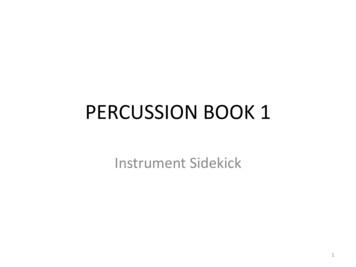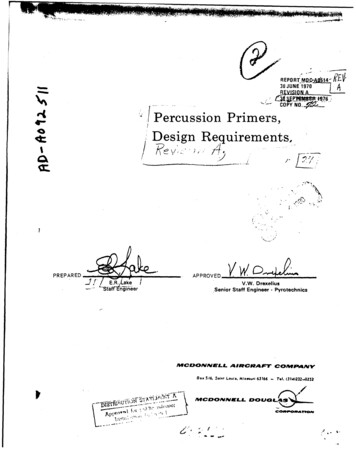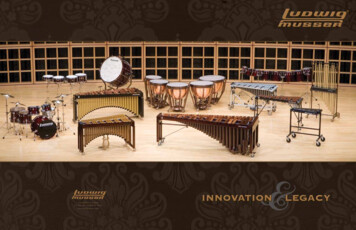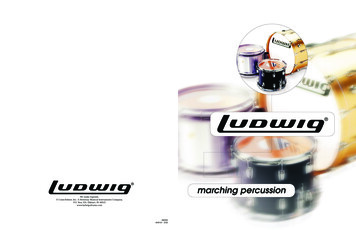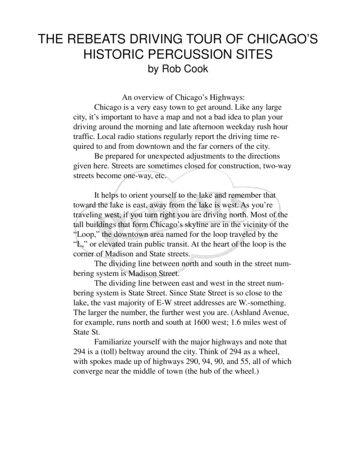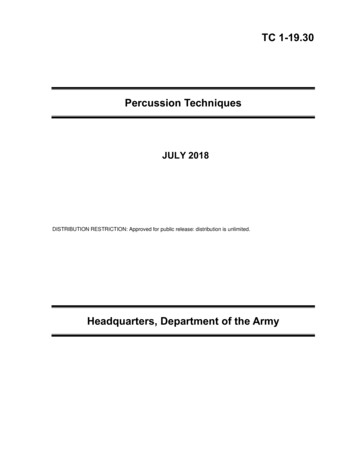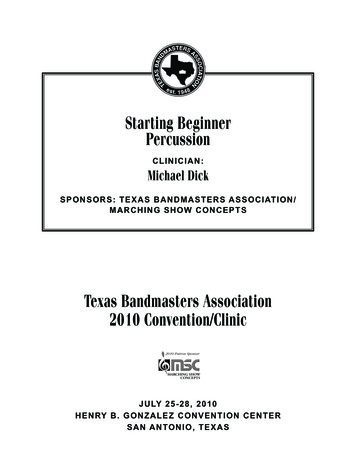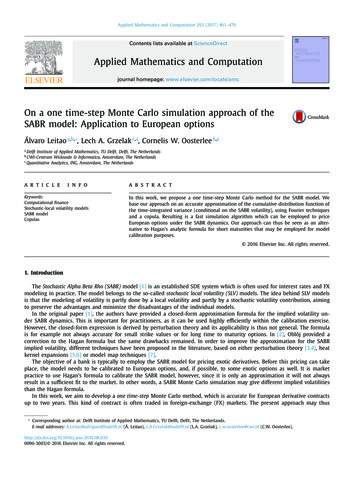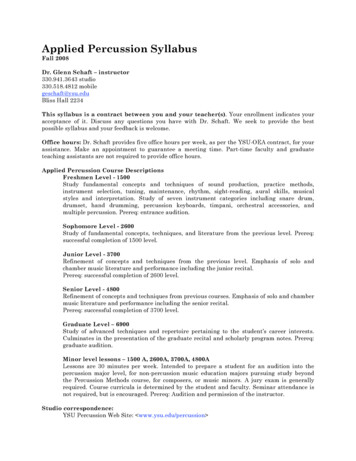
Transcription
Applied Percussion SyllabusFall 2008Dr. Glenn Schaft – instructor330.941.3643 studio330.518.4812 mobilegeschaft@ysu.eduBliss Hall 2234This syllabus is a contract between you and your teacher(s). Your enrollment indicates youracceptance of it. Discuss any questions you have with Dr. Schaft. We seek to provide the bestpossible syllabus and your feedback is welcome.Office hours: Dr. Schaft provides five office hours per week, as per the YSU-OEA contract, for yourassistance. Make an appointment to guarantee a meeting time. Part-time faculty and graduateteaching assistants are not required to provide office hours.Applied Percussion Course DescriptionsFreshmen Level - 1500Study fundamental concepts and techniques of sound production, practice methods,instrument selection, tuning, maintenance, rhythm, sight-reading, aural skills, musicalstyles and interpretation. Study of seven instrument categories including snare drum,drumset, hand drumming, percussion keyboards, timpani, orchestral accessories, andmultiple percussion. Prereq: entrance audition.Sophomore Level - 2600Study of fundamental concepts, techniques, and literature from the previous level. Prereq:successful completion of 1500 level.Junior Level - 3700Refinement of concepts and techniques from the previous level. Emphasis of solo andchamber music literature and performance including the junior recital.Prereq: successful completion of 2600 level.Senior Level - 4800Refinement of concepts and techniques from previous courses. Emphasis of solo and chambermusic literature and performance including the senior recital.Prereq: successful completion of 3700 level.Graduate Level – 6900Study of advanced techniques and repertoire pertaining to the student’s career interests.Culminates in the presentation of the graduate recital and scholarly program notes. Prereq:graduate audition.Minor level lessons – 1500 A, 2600A, 3700A, 4800ALessons are 30 minutes per week. Intended to prepare a student for an audition into thepercussion major level, for non-percussion music education majors pursuing study beyondthe Percussion Methods course, for composers, or music minors. A jury exam is generallyrequired. Course curricula is determined by the student and faculty. Seminar attendance isnot required, but is encouraged. Prereq: Audition and permission of the instructor.Studio correspondence:YSU Percussion Web Site: www.ysu.edu/percussion
Studio Bulletin Board: 2234 Bliss Hall.Course materials fee: 35 fee to maintain YSU gear provided for this course.Practice room keys: Sign-out keys 5607 and 5732 from the Dana office. You must register forapplied percussion to receive keys and they may be kept during the summer provided you will enrollthe following semester.Lockers for personal items are available through the Kilcawley Center.Borrowed items: from Dr. Schaft must be returned as requested in their original condition. Youmust replace any lost or damaged items.Percussive Arts Society: www.pas.org I encourage you to maintain an active PAS membershipand attend the PASIC conventions, during which no YSU percussion events are scheduled.Percussion Ensemble enrollment: is expected concurrent with each semester of Applied Lessons.Other Dana Ensembles: Ensemble assignments are determined by: audition results, facultyassignments, ensemble personnel needs, your degree program, & your preferences.Section-leader duties. Large ensembles (bands & orchestras) will each have a facultyappointed section leader who coordinates logistics such as part assignments, set-ups, gear moves,and offers artistic suggestions. For equipment moves: 1. Write an equipment list and give it to thegraduate assistant one-week prior to the move. 2. Schedule equipment packing and unpackingsessions with your section colleagues well before the scheduled move and post this on the PercussionBulletin Board, as all section members should be present. 3. Pack gear and place by northwest doorof room 2326. 4. Unpack gear as soon as it is returned to Bliss Hall so as to minimize impact on otherensembles.Americans with Disabilities Act: “Anyone requiring special adaptations or accommodationsshould inform the instructor as soon as possible. In accordance with University procedures, if youhave a documented disability and require accommodations to obtain equal access in this course,please contact the Office of Disability Services (phone: 330-941-1372) in the Center for StudentProgress at the beginning of the semester or when given an assignment for which an accommodationis required. Students with disabilities must verify their eligibility through the Office of DisabilityServices.”Required and Recommended MaterialsIt is your responsibility to acquire materials as requested by the faculty.Required items:1. E-mail account. Notify Dr. Schaft immediately of any address changes.2. Internet access www.ysu.edu/percussion3.Academic Datebook - bring to all percussion classes.4. Three ring binder 1.5” minimum, to house portfolio. Include loose-leaf ruled writingpaper and manuscript paper. Bring to all classes.5. Ear Plugs. I recommend a pair of quality audiologist fitted plugs from a company such asWestone or Microsonic, 15dB attenuation. Alternatively, Hearos, 12 dB. http://www.hearnet.com/6. Metronome. Recommend – Yamaha Click Station, Roland Dr. Beat.Recommended Items:1. Percussion Retailers Local retailers:
Drum Shop in Struthers - Craig & Larry, 330.755.9463Hubbard Music, Mark Tirabassi, 330.534-3900Mail-order retailers – sources for books, music, recordings, and instrumentsThe Percussion Source, Coralville, Iowa. www.percussionsource.comSteve Weiss Music, Philadelphia, PA. www.steveweissmusic.com2. Gum rubber practice pad. Recommended Reel Feel, Yamaha, Sabian, ProMark orsimilar model.3. Mallet cases:A. Briefcase, small suitcase, or large stickbag for orchestral mallets. InnovativePercussion Bag or Mike Balter mallet bag.B. Stickbag for drumset sticks and mallets.C. Small briefcase for timpani mallets and related gear.4. Portable recording system to record lessons, practice, clinics, and performances. Bringto all lessons and seminars.5. Timpani tuning fork (A-440) for sophomores or a F-F chromatic tuning pipe forfreshmen.6. Drum key. Keep in your stick-bag.7. Music notation software. I recommend Sibelius 5.Recommended Books:My books are available directly from me via cash or check. Your applied teacher will recommendbooks and music they require. Commonly used books are listed below. Please discuss proposedpurchases with your teacher to minimize expenses.GeneralHarvard Concise Dictionary of Music and Musicians www.amazon.comGlenn Schaft – Percussion HandbookSnare drumGlenn Schaft – Chops and ConceptsMitchell Peters - Intermediate Studies for Snare Drum.Gary Chaffee – Rhythm and Meter Patterns.Charles Wilcoxon – All American Drummer – 150 SolosGuy Gauthreaux – Six Classic Snare Drum SolosGeorge Lawrence Stone – Stick ControlKeyboardGlenn Schaft – Keyboard HandbookMitchell Peters - Fundamental Method for MalletsVolume 1 - freshman.Volume 2 - sophomoresGifford Howarth – Simply Four www.tapspace.comDavid Friedman – Vibraphone Technique-dampening and pedalingTimpaniGlenn Schaft – Timpani HandbookMitchell Peters - Fundamental Method for TimpaniDrum SetGlenn Schaft – Drumset HandbookMick Berry & Jason Gianni – The Drummer’s Bible. Sharp Press, 2004. ISBN #1-884365-32-9. Website www.seesharppress.com Can be ordered through Barnes & Noble, Amazon, etc.Gary Chaffee - Technique Pattern.
Gary Chaffee – Time Functioning PatternsLatin PercussionMichael Spiro – The Conga Drummer’s Guidebook www.shermusic.comEd Uribe – Afro-Cuban Percussion and DrumsetEd Uribe – The Essence of Brazilian Percussion and DrumsetOrchestral AccessoriesRaynor Carroll books as requested by your instructor. Xylo, Glock, SD, BD/Cym, Tri/Tamb/Cast.BM Jazz Emphasis Degree. Jazz emphasis majors should also own the following.John Riley – The Art of Bop Drumming.Gary Chaffee – Linear Time PlayingZoro – The Commandments of R&B DrummingEd Uribe – The Essence of Brazilian Percussion and DrumsetArthur Lipner – Vibes Real Book.Recommended Implements Pair concert snare drum sticks. ProMark - Tom Freer - General Orchestral model or ProMark EX-5.These must be straight, pitch matched, and the same weight. Pair 5-A wood-tip hickory drumset sticks with acorn shaped tips. These must be straight, pitchmatched, and the same weight. Pair telescoping wire brushes with rubber handles and wire end-rings. Regal Tip, ProMark, orZildjian. Plastic brushes are not acceptable. Be sure they do not rattle. Pair natural rubber mallets on rattan shafts. Tom Freer FRK3 light green natural rubber model onrattan shafts or Malletech - Natural Rubber NR13R model, rattan handles. Set of 4 yarn or wool wrapped marimba mallets on birch or maple handles. Medium hardness.ProMark EXM-130. Set of 4 cord wrapped vibraphone mallets on rattan shafts. Medium hardness. Pair xylophone mallets suitable for rosewood instruments, rattan handles. Tom Freer – FRK9Large Brown Linen Phenolic or Black Swamp Inaki Sebastian 28mm rosewood core on rattanhandle. Hard plastic mallets are not acceptable as they dent rosewood instruments. Pair medium-hard timpani mallets. Clevelander, Cloyd Duff, Black Swamp, Vic Firth EuropeanSeries, etc.Instruments Snare drum (5 or 6.5”x14”) with case, suitable for orchestral and rudimental studies. I will help youcustomize with appropriate cable snares, heads, and dampening. Black Swamp or Pearl concertdrums are recommended. Please contact me before bringing drumsets or other large instruments to campus. Fundamental learning goals – general course objectivesAn effective course should involve six general types of learning:1. Foundational knowledge: you should understand and remember the basic content of thecourse including fundamental concepts of percussion equipment, sound production techniques, andpedagogical techniques. The course may consist of lectures, demonstrations, discussions, in-classplaying, individual practice, in-class playing exams, reading assignments, written concert critiques,percussion lesson observation and analysis paper, and interview report paper.2. Application: you should use the content and engage in effective and appropriate kinds ofthinking.
3. Integration: you should integrate different disciplines, major ideas, and realms of life.4. Human dimension: you should identify the personal and social implications of thisknowledge.5. Caring: you should develop new feelings, interests, and values in relation to the subject.6. Learning how to learn: you should continue learning about the subject after the course iscompleted. Course Components1. Private Lessons are intended to address individual needs. Most music schools offer 15private 50’ lessons per semester. In addition to private lessons, we assign weekly small group lessonsand the number of private lessons must be reduced to adhere to faculty workload regulations.Typically, you will receive thirteen private lessons per semester. Your class schedule is due the firstday of classes. Teacher assignments are made in consideration of your past achievement, studentand faculty schedules, and what will be most beneficial for your development. Every effort is made toprovide you experience with various teachers. Please notify your teacher of your presence byknocking on their door at your lesson time - use 3/2 rumba clave. It is your responsibility to notifyyour teacher when you must leave.2. Group lessons are designed to study with colleagues of similar abilities, interests, andexperience levels in an interactive environment. Group lessons meet weekly for 50’.3. Percussion seminar class is a weekly forum (Friday 12-12:50) for all majors. Includeslectures, discussions, student performances, masterclasses, clinics, and guest artist performances.Student performances typically occur in a masterclass format, where you perform and receivefeedback from faculty and students. Repertoire is derived from private lessons, group lessons, orvarious Dana ensembles. You may also be required to submit written or aural comments for eachperformer. Masterclass protocol: Dress appropriately and bring two copies of your music, numbermeasures in pencil, audio record your performance and the feedback, take notes afterwards.4. Rehearsal observation. I may choose to dedicate a small amount (an hour or two) ofyour lesson time to observing your ensemble rehearsals, as seeing you in this context may be the bestway I can assist you. In such cases I will adjust your lessons accordingly.5. Percussion studio maintenance duties may be assigned at my discretion and shall beequitably distributed amongst all studio members.6. Required advisement meetings.A. Brief advisement meeting first class day to review your schedule and curriculum guide.B. 15’ meeting during final exams to discuss self and instructor assessment, review jurycomments, assessment, and future studies. Sign-up list is posted the last week of classes.C. Recital advisement meeting during the first two weeks of fall semester.D. Additional advisement meetings (during office hours) may be required for registration,orientation, recital preparation, graduate school preparation, etc. Specific Course ObjectivesYou should develop knowledge in three broadlymental/physical skills, and related business skills.relatedareas-performance/pedagogy,1. Performance/Pedagogy. Develop a deep understanding through multiple perspectives offundamental performance and teaching skills. Experience music through the three primary modes ofcreation: re-presentation, improvisation, and composition. You and your instructor will establishsemester and weekly goals and discuss how to attain these. These typically include:A. Warm-up concepts, techniques, and methods.B. Practice
Gary Chaffee – Time Functioning Patterns Latin Percussion Michael Spiro – The Conga Drummer’s Guidebook www.shermusic.com Ed Uribe – Afro-Cuban Percussion and Drumset Ed Uribe – The Essence of Brazilian Percussion and Drumset Orchestral Accessories Raynor Carroll books as requested by your instructor.
